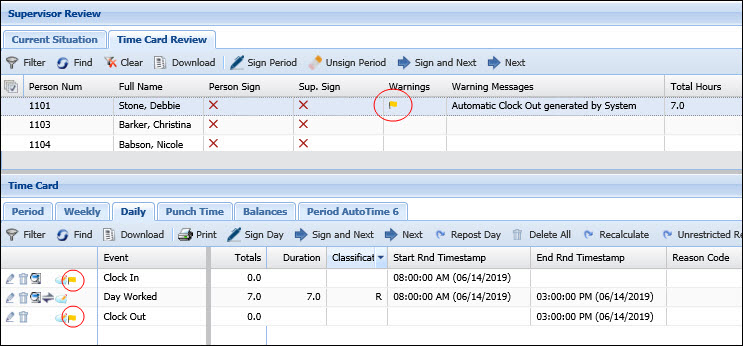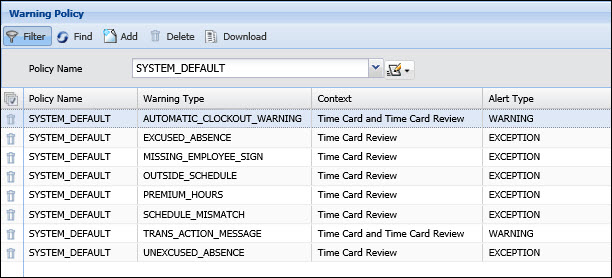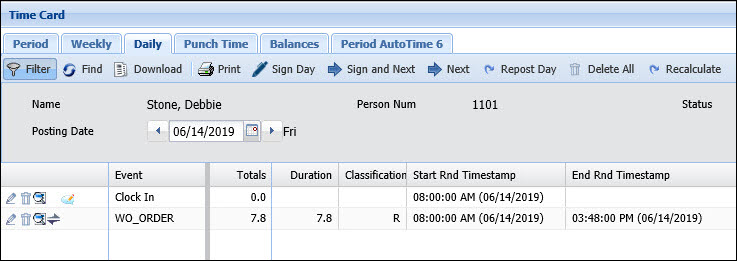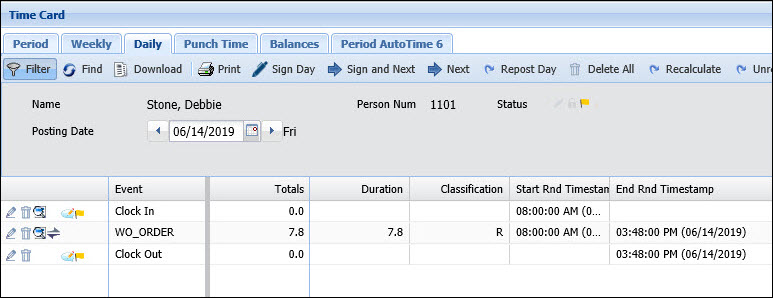
The Automatic Clock Out feature allows the system to automatically post a clock out when a person has failed to clock out.
When an automatic clock out is posted, you can configure a warning flag to display in the timecard. Both the supervisor and the employee can also receive a message when an automatic clock out is posted. The warning flag and message will alert the supervisor of the automatic clock out, in case any adjustments need to be made. For example, an employee forgets to clock out and an automatic clock out posts at the employee's scheduled end time. The supervisor sees the warning on the employee's timecard and knows the employee stayed late and worked overtime that day. The supervisor is able to correct the employee's timecard accordingly.
The Automatic Clock Out feature is configured in a person's Clock Policy. An automatic clock out can be posted at the end of the person's schedule or at the time of the person's last recorded activity.
The automatic clock out warning flag is configured in a person's Warning Policy. Automatic clock out messages are configured in the person's Message Policy.
Automatic clock outs are posted by the AUTOMATIC_CLOCKOUT task of the ATTENDANCE service.
This feature requires the Automatic Clock Out module to be enabled in your license.
See Also:
Configuring the Clock Policy for Automatic Clock Outs
Configuring the Automatic Clock Out Warnings
Configuring the Automatic Clock Out Messages
Configuring the ATTENDANCE Service to Post Automatic Clock Outs
The following settings in the Clock Policy are used to configure the Automatic Clock Out feature.
Once you have configured your Clock Policy, you need to assign it to the employees who will be automatically clocked out by the ATTENDANCE service.
Sch OT ClockOut
This determines the timestamp of an automatic clock out that is posted by the ATTENDANCE service for a pre-shift or post-shift Overtime Schedule. Overtime Schedules are configured on the Properties tab of the schedule forms or when an overtime offer is authorized.
The ATTENDANCE service will check to see if the current time is after the end time of the assigned Overtime Schedule plus the Max Missing Clk Out hours. If this condition is met, the service will post an automatic clock out. The timestamp of the automatic clock out will be based on one of the settings below.
At Schedule End: The timestamp of the automatic clock out will be the end time of the assigned Overtime Schedule.
At Last Activity: The timestamp of the automatic clock out will be the last recorded activity.
At Last Activity Plus 1 Second: The timestamp of the automatic clock out will be the last recorded activity plus one second.
If the person does not have a schedule on the date being processed, the ATTENDANCE service will check to see if the current time is after the last recorded activity plus the Max Missing Clk Out hours. If this condition is met, the service will post an automatic clock out. The timestamp of the automatic clock out will be the last recorded activity.
Gap OT ClockOut
This determines the timestamp of an automatic clock out that is posted by the ATTENDANCE service for a Gap Day Overtime Schedule. Overtime Schedules are configured on the Properties tab of the schedule forms or when an overtime offer is authorized.
The ATTENDANCE service will check to see if the current time is after the end time of the Gap Day Overtime Schedule plus the Max Missing Clk Out hours. If this condition is met, the service will post an automatic clock out. The timestamp of the automatic clock out will be based on one of the settings below.
At Schedule End: The timestamp of the automatic clock out will be the end time of the Gap Day Overtime Schedule.
At Last Activity: The timestamp of the automatic clock out will be the last recorded activity.
At Last Activity Plus 1 Second: The timestamp of the automatic clock out will be the last recorded activity plus one second.
If the person does not have a schedule on the date being processed, the ATTENDANCE service will check to see if the current time is after the last recorded activity plus the Max Missing Clk Out hours. If this condition is met, the service will post an automatic clock out. The timestamp of the automatic clock out will be the last recorded activity.
ClockOut Time
This determines the timestamp of an automatic clock out that is posted by the ATTENDANCE service for a non-overtime schedule. The ATTENDANCE service will check to see if the current time is after the scheduled end time plus the Max Missing Clk Out hours. If this condition is met, the service will post an automatic clock out. The timestamp of the automatic clock out will be based on one of the settings below.
At Schedule End: The timestamp of the automatic clock out will be the scheduled end time.
At Last Activity: The timestamp of the automatic clock out will be the last recorded activity.
At Last Activity Plus 1 Second: The timestamp of the automatic clock out will be the last recorded activity plus one second.
If the person does not have a schedule on the date being processed, the ATTENDANCE service will check to see if the current time is after the last recorded activity plus the Max Missing Clk Out hours. If this condition is met, the service will post an automatic clock out. The timestamp of the automatic clock out will be the last recorded activity.
Max Missing Clk Out
This is the number of hours past the employee's scheduled clock out time when the ATTENDANCE service will post the automatic clock out.
If the employee does not have a schedule, the ATTENDANCE service will post the automatic clock out this number of hours after the last recorded activity.
The timestamp of the automatic clock out will be based on the Sch OT ClockOut, Gap OT ClockOut, or ClockOut Time setting.
For example, a person is scheduled to work from 8 a.m. to 4 p.m. He clocks in at 8 a.m. and stops his last labor at 3 p.m. He forgets to clock out and goes home.
In the Clock Policy, the ClockOut Time is At Last Activity and Max Missing Clk Out is set to 4.0 hours.
If the ATTENDANCE service runs at 6 p.m., the automatic clock out will not post because it has not been 4 hours since the end of the schedule. If the ATTENDANCE service runs at 8 p.m. or later, it will post the automatic clock out. The automatic clock out time will be the time of the last activity (in this case, 3 p.m.).
Clk Out Affects Sign
This indicates whether the AUTOMATIC_CLOCKOUT task of the ATTENDANCE Service will remove employee and supervisor signatures from the timecard. This setting only affects employees whose Sign Policy has the Sign Mode set to Always or Exception.
If Clk Out Affects Sign is selected, the timecard will be unsigned when the ATTENDANCE service posts an automatic clock out. By default, this check box is selected.
If Clk Out Affects Sign is not selected, the timecard will not be unsigned when the ATTENDANCE service posts an automatic clock out.
Note that the automatic clock out process may add supporting events, such as Early Departure or Bonus Hours, to the timecard. If Clk Out Affects Sign is not selected, the timecard signatures will not be removed even though the time on the timecard has changed because of these additional postings.
See Clk Out Affects Sign - Examples for more information.
If you want to display a yellow warning flag in the timecard when the ATTENDANCE service posts an automatic clock out, you need to configure and assign a Warning Policy.

To display this warning flag, you must include the AUTOMATIC_CLOCKOUT_WARNING in the Warning Policy. Make sure you assign this Warning Policy to the employees who will be receiving automatic clock outs and their supervisors.

The timecard warning flag will only appear in the web or mobile timecard. The timecard that displays on a client terminal will not show this warning flag. However, you can configure automatic clock out messages (see below) to alert the user of the automatic clock in when they log into the terminal.
A warning flag displays next to the clock in and clock out, and in the Status field of the timecard. If the user hovers over the flag next to the clock event, the warning message displays. If the user hovers over the warning flag in the Status section, the number of warnings in the day, week, or period will display. Note that on the Daily tab of the timecard, this warning count will include any cancelled warnings as well.
Note that the same warning flag displays on both the Clock In and Clock Out events, even though it was only the clock out that posted automatically. These events represent the same transaction with a start time (clock in) and an end time (clock out).
If an automatic clock out posts on the split day of a 9-80 schedule, the timecard will display the warning flag on the half of the day where it occurred.
Refer to the Example for illustrations of the warning flags.
The warning flag may be removed depending on the type of adjustments made to the day's transactions. For example, if you modify a labor event so that it overlaps the automatic clock out and you select Move Overlapping Punches and Move Adjacent Punches, the clock out time will change and the warning flag will be removed. However, if you modify the labor event and it does not overlap the automatic clock out, the warning flag will not be removed.
To view any cancelled warning flags, you need to set Show Adjustments to ALL in your Preferences. This setting will show all the transactions that were adjusted in the person's timecard, including any automatic clock out warnings. The warning flag that displays in the Status section of the Daily timecard will continue to show the count of all the warning flags for the day, including any cancelled warnings.
You can configure a Message Policy to create a message when the ATTENDANCE service posts an automatic clock out. To do so, make sure the AUTOMATIC_CLOCKOUT_WARNING Message Trigger is included in the Message Policy.
The Message Policy needs to be assigned to the employees and supervisors who will receive the automatic clock out message.
Use the SEND Trigger Settings to create a message alert or email message for the person who received the automatic clock out and/or that person's supervisor.
Note that if you enable the SEND_EMAIL settings, you will have to run the MESSAGE_DELIVERY service to send the message.
You can change the message label (Automatic Clock Out generated by System) or the email message text using the Change Trigger Label button on the Message Policy form.
You will need to configure the ATTENDANCE service to post automatic clock outs by enabling the AUTOMATIC_CLOCKOUT task in the service instance.
The AUTOMATIC_CLOCKOUT task looks for a clock in without a matching clock out for each person and post date it processes. When the service finds a missing clock out, it then checks for the person's schedule on that post date.
If the person does not have a schedule, the service checks to see if the current time is after the person's last recorded activity plus the Max Missing Clk Out hours in the person's Clock Policy. If this condition is met, the service posts an automatic clock out. The timestamp of the automatic clock out will be the timestamp of the last recorded activity.
If the person does have a schedule, the ATTENDANCE service will check to see if the current time is after the scheduled end time plus the Max Missing Clk Out hours. If this condition is met, the service will post an automatic clock out. The timestamp of the automatic clock out will be based on the Sch OT ClockOut, Gap OT ClockOut, or ClockOut Time setting in the person's Clock Policy (depending on the kind of schedule the person has). For example, a person has a Normal, non-overtime schedule. In the Clock Policy, the ClockOut Time setting is At Last Activity. The ATTENDANCE service will check to see if the current time is after the scheduled end time plus the Max Missing Clk Out hours. If this condition is met, the service will post an automatic clock out with the timestamp of the last recorded activity.
The ATTENDANCE service with the AUTOMATIC_CLOCKOUT task needs to be configured to run for the Employee Groups whose members will need to have automatic clock outs.
An employee is scheduled to work from 8 a.m. to 4 p.m. Her Clock Policy has ClockOut Time set to At Last Activity and the Max Missing Clk Out is 4 hours.
The employee clocks in at 8 a.m. and starts a work order. She finishes the work order at 3:48 p.m. and goes home, forgetting to clock out.

When the ATTENDANCE service runs at 8:30 p.m., it posts an automatic clock out with a timestamp of 3:48 p.m. A warning flag displays next to the clock in and clock out, and in the Status field of the timecard.

If the user hovers over this flag next to the clock event, the warning message displays.

If the user hovers over the warning flag in the Status section, the number of warnings in the day, week, or period will display.

On the Time Card Review form, the supervisor can also view the warning message.

In the illustration below, the employee has a 9-80 schedule. On the split Friday, the employee clocks in at 8 a.m., starts a labor, and stops a labor at 3 p.m. The employee continues working until the end of her shift and then goes home without clocking out.
An automatic clock out posts on the second half of the day. The warning flag is visible in the Daily timecard. Note that the Clock Out/Clock In in the middle of the day occurs automatically as a result of the split schedule.

In the Period or Weekly timecard, the warning flag will only be visible when the second half of the day is showing.


